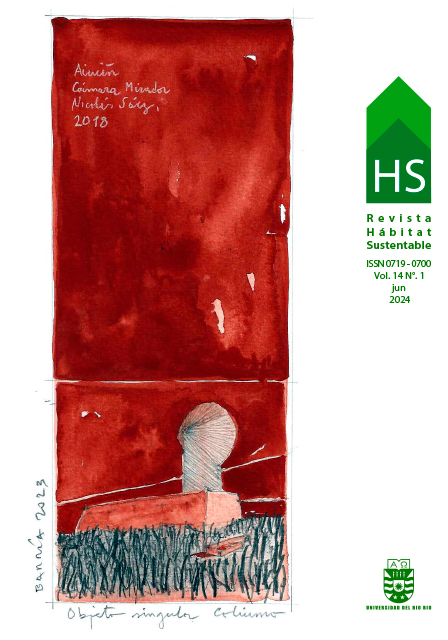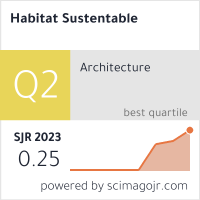Optimizaciones en el diseño de mezclas de concreto para la sostenibilidad de un Área Metropolitana de Sudamérica implementando análisis de ciclo de vida de materiales
DOI:
https://doi.org/10.22320/07190700.2024.14.01.04Palabras clave:
análisis de ciclo de vida ACV, sostenibilidad, optimización de agregados, producción de concretoResumen
El análisis de Ciclo de Vida ACV, es una metodología que identifica los aspectos ambientales y los impactos potenciales asociados con un producto mediante la compilación de un inventario de las entradas y salidas del sistema para su optimización, planificación estratégica e implementación de políticas sostenibles. En el ámbito de la producción de concretos, se han utilizado diversas técnicas de optimización y su impacto en el diseño de mezclas como análisis multicriterio, modelos estadísticos, materiales cementantes suplementarios y algoritmos de optimización. Este trabajo aplica el ACV a la producción de concreto el Área Metropolitana del Valle de Aburrá, Colombia, con la hipótesis de optimizar las proporciones, sin agregar aditivos ni adiciones especiales, se puede reducir las emisiones de CO₂ y el consumo de energía. Utilizando la metodología ACI 211, se diseñaron mezclas de concreto y se evaluaron sus impactos ambientales. Los resultados muestran que el uso de agregados gruesos de mayor tamaño reduce el consumo de cemento, disminuyendo las emisiones de CO₂ hasta un 15%. La mezcla óptima no sólo es más económica, sino también de menor impacto ambiental. Las conclusiones indican que es posible compatibilizar la eficiencia económica, promoviendo la disminución en la huella de carbono.
Descargas
Citas
AGUSTI-PANAREDA, A., DIAMANTAKIS, M., MASSART, S., CHEVALLIER, F., MUÑOZ SABATER, J., BARRÉ, J., CURCOLL, R., ENGELEN, R., LANGEROCK, B., LAW, R., LOH, Z., MORGUÍ, J., PARRINGTON, M., PEUCH, V.-H., RAMONET, M., ROEHL, C., VERMEULEN, A., WARNEKE, T., y WUNCH, D. (2019). Modelling CO2 weather – why horizontal resolution matters. Atmospheric Chemistry and Physics, 19(11), 7347-7376. https://doi.org/10.5194/acp-19-7347-2019
AJAYI, B. L., y BABAFEMI, A. J. (2024). Effects of Waste Plastic and Glass Aggregates on the Strength Properties of Ambient-Cured One-Part Metakaolin-Based Geopolymer Concrete. Applied Sciences, 14(5). https://doi.org/10.3390/app14051856
Alcaldía de Medellín. (2020). PLAN DE ACCIÓN CLIMÁTICA MEDELLIN 2020-2050. https://www.medellin.gov.co/es/secretaria-medio-ambiente/cambio-climatico/#:~:text=El%20Plan%20de%20Acci%C3%B3n%20Clim%C3%A1tica,aporte%20al%20logro%20de%20la
Alcaldía de Medellín. (2021). Plan de Acción Climática (PAC) 2020-2050. https://www.medellin.gov.co/es/secretaria-medio-ambiente/cambio-climatico/#:~:text=El%20Plan%20de%20Acci%C3%B3n%20Clim%C3%A1tica,aporte%20al%20logro%20de%20la
AMVA. (2015). Política Pública de Construcción Sostenible 1. Línea Base. https://www.metropol.gov.co/ambiental/Documents/Construccion_sostenible/PPCSILineaBase27112015.pdf
AMVA. (2017). Plan Integral de Gestión de la Calidad del Aire para el Área Metropolitana del Valle de Aburrá (PIGECA 2017-2030). https://www.metropol.gov.co/ambiental/calidad-del-aire/Paginas/Gestion-integral/PIGECA.aspx
Asoareas. (2021). Mapa general localización Área Metropolitana del Valle de Aburrá. https://Asoareas.Com.Co/Alianzas-Estrategicas/Area-Metropolitana-Del-Valle-de-Aburra/
AZARI, R. (2019). Life Cycle Energy Consumption of Buildings; Embodied + Operational. Sustainable Construction Technologies: Life-Cycle Assessment, 123–144. https://doi.org/10.1016/B978-0-12-811749-1.00004-3
BELAÏD, F. (2022a). How does concrete and cement industry transformation contribute to mitigating climate change challenges? Resources, Conservation y Recycling Advances, 15, 200084. https://doi.org/https://doi.org/10.1016/j.rcradv.2022.200084
BELAÏD, F. (2022b). Implications of poorly designed climate policy on energy poverty: Global reflections on the current surge in energy prices. Energy Research & Social Science, 92, 102790. https://doi.org/https://doi.org/10.1016/j.erss.2022.102790
Berkeley. (s.f.). Green Concrete LCA Web Tool. https://greenconcrete.berkeley.edu/
BOCCIA, F., y SARNACCHIARO, P. (2018). The Impact of Corporate Social Responsibility on Consumer Preference: A Structural Equation Analysis. Corporate Social Responsibility and Environmental Management, 25(2), 151–163. https://doi.org/https://doi.org/10.1002/csr.1446
BOHVALOVS, G., KALNBAĻĶĪTE, A., VANAGA, R., KIRSANOVS, V., LAUKA, D., PAKERE, I., PRODANUKS, T., LAKTUKA, K., DOLGE, K., ZUNDĀNS, Z., BRĒMANE, I., BLUMBERGA, D., y BLUMBERGA, A. (2023). Increasing Sustainability in Vocational Education System: Latvia Case Study. CONECT. International Scientific Conference of Environmental and Climate Technologies, 0, 32. https://doi.org/10.7250/CONECT.2023.014
BUSH, E., FLATO, C., GILLETT, J., GREENAN, N., JAMES, B. J. W., y KIRCHMEIER-YOUNG. (2022). Canada’s Changing Climate Report in Light of the Latest Global Science Assessment. https://www.nrcan.gc.ca/environment/impacts-
Construction Leadership Council (CLC ). (2016). Guidance Document for PAS 2080.
CHERTOW, M. R. (2004). Industrial Symbiosis. Encyclopedia of Energy, 407–415. https://doi.org/10.1016/B0-12-176480-X/00557-X
CROWTHER, D., y SEIFI, S. (2022). The Equal Pillars of Sustainability. Emerald Publishing Limited. https://books.google.com.co/books?id=G8C3zgEACAAJ
DAMIANI, M., FERRARA, M., y ARDENTE, F. (2022). Understanding Product Environmental Footprint and Organisation Environmental Footprint methods. https://doi.org/10.2760/11564
DANE. (2023). Boletín técnico.
DAS, A., KUMAR, S., SHARMA, P., y SHARMA, N. (2023). Environmental Effects of Cement Production: A Review. In A. K. Shukla, B. P. Sharma, A. Arabkoohsar, y P. Kumar (Eds.), Recent Advances in Mechanical Engineering (pp. 597–608). Springer Nature Singapore.
DE ANDRADE SALGADO, F., y DE ANDRADE SILVA, F. (2022). Recycled aggregates from construction and demolition waste towards an application on structural concrete: A review. Journal of Building Engineering, 52, 104452. https://doi.org/https://doi.org/10.1016/j.jobe.2022.104452
DEL REY CASTILLO, E., ALMESFER, N., SAGGI, O., y INGHAM, J. (2020). Light-weight concrete with artificial aggregate manufactured from plastic waste. Construction and Building Materials, 265, 120199. https://doi.org/10.1016/j.conbuildmat.2020.120199
DUQUE, J. A. (2020). Medición del impacto ambiental de bloques de suelo-cemento, bloques cerámicos y bloques de concreto por el método de análisis de ciclo de vida. Universidad Nacional de Colombia. https://repositorio.unal.edu.co/handle/unal/79160
EFCA. (2015). Environmental Product Declaration: Concrete Admixtures—Plasticizers and Superplasticizers (Berlin, Germany: European Federation of Concrete Admixtures Association Ltd)
European Commission. (2021). Understanding Product Environmental Footprint and Organisation Environmental Footprint methods. https://green-business.ec.europa.eu/environmental-footprint-methods_en
Europäische Kommission Statistisches Amt. (2018). Economy-wide material flow accounts handbook. 2018 edition, Luxembourg: Publications Office of the European Union. https://data.europa.eu/doi/10.2785/158567
GHADIR, P., ZAMANIAN, M., MAHBUBI MOTLAGH, N., SABERIAN, M., LI, J., y RANJBAR, N. (2021). Shear strength and LCA of volcanic ash-based geopolymer and cement stabilized soil: a comparative study. Transportation Geotechnics, 31, 100639. https://doi.org/10.1016/j.trgeo.2021.100639
GOYAL, H., KUMAR, R., y MONDAL, P. (2023). Life cycle analysis of paver block production using waste plastics: Comparative assessment with concrete paver blocks. Journal of Cleaner Production, 402, 136857. https://doi.org/https://doi.org/10.1016/j.jclepro.2023.136857
GURSEL, A., MASANET, E., HORVATH, A., y STADEL, A. (2014). Life-cycle inventory analysis of concrete production: A critical review. Cement and Concrete Composites, 51. https://doi.org/10.1016/j.cemconcomp.2014.03.005
HAFEZ, H., KURDA, R., CHEUNG, W., y NAGARATNAM, B. (2019). A Systematic Review of the Discrepancies in Life Cycle Assessments of Green Concrete. Applied Sciences, 9(22), 4803. https://doi.org/10.3390/app9224803
HENDERSON, A.D., NIBLICK, B., GOLDEN, H.E. y BARE, J.C. (2021). Modeling spatially resolved characterization factors for eutrophication potential in life cycle assessment. The International Journal of Life Cycle Assessment, 26, 1832-1846. https://doi.org/10.1007/s11367-021-01956-4
ICONTEC. (2021). NTC-ISO 14044:2021. Gestión Ambiental. Análisis de Ciclo de Vida. Requisitos y Directrices. Requisitos Del Ciclo de Vida.
Industrial Conconcreto S.A.S. (2019). Declaración Ambiental de Producto ARENA, TRITURADO 1” Y 3/8”.
JAMIL, S., SHI, J., y IDREES, M. (2023). Effect of various parameters on carbonation treatment of recycled concrete aggregate using the design of experiment method. Construction and Building Materials, 382, 131339. https://doi.org/10.1016/j.conbuildmat.2023.131339
JAYASURIYA, J., BASAVARAJ, A. S., SINGH, S., y GETTU, R. (2023). Sustainability Assessment of Concrete Pavements with Recycled Concrete Aggregate. In J. I. Escalante-Garcia, P. Castro Borges, y A. Duran-Herrera (Eds.), Proceedings of the 75th RILEM Annual Week 2021 (pp. 363–371). Springer International Publishing.
KIM, A., CUNNINGHAM, P., KAMAU-DEVERS, K., y MILLER, S. (2022). OpenConcrete: a tool for estimating the environmental impacts from concrete production. Environmental Research: Infrastructure and Sustainability, 2(4). https://doi.org/10.1088/2634-4505/ac8a6d
KNEIFEL, J., LAVAPPA, P., POLIDORO, B., y GREIG, A. L. (2019). Building for Environmental and Economic Sustainability (BEES) Online 2.1 technical manual. https://doi.org/10.6028/NIST.TN.2032r.
KOSKELA, L., FERRANTELLI, A., NIIRANEN, J., PIKAS, E., y DAVE, B. (2019). Epistemological Explanation of Lean Construction. Journal of Construction Engineering and Management, 145(2). https://doi.org/10.1061/(asce)co.1943-7862.0001597
LIU, B., MARTRE, P., EWERT, F., WEBBER, H., WAHA, K., THORBURN, P., RUANE, A., AGGARWAL, P. K., AHMED, M., BALKOVIČ, J., BASSO, B., BIERNATH, C., BINDI, M., CAMMARANO, D., CAO, W., CHALLINOR, A., DE SANCTIS, G., DUMONT, B., ESPADAFOR, M., y PAKISTAN, R. (2023). AgMIP-Wheat multi-model simulations on climate change impact and adaptation for global wheat. Open Data Journal for Agricultural Research, 9, 10-25. https://doi.org/10.18174/odjar.v9i0.18092
LIU, Z., NIU, Y., GUO, C., y JIA, S. (2023). A Vehicle Routing Optimization Model for Community Group Buying Considering Carbon Emissions and Total Distribution Costs. Energies, 16(2). https://doi.org/10.3390/en16020931
MARTINSONE, B., DI SANO, S., D’ELIA, P., y SALLE-FINLEY, T. (2023). A Conceptual Framework for Sustainable Promotion of a Positive School Climate: Context, Challenges, and Solutions. Journal of Teacher Education for Sustainability, 25, 64-85. https://doi.org/10.2478/jtes-2023-0005
MOCOVÁ, K. A., SACKEY, L. N. A., y RENKEROVÁ, P. (2019). Environmental Impact of Concrete and Concrete-Based Construction Waste Leachates. IOP Conference Series: Earth and Environmental Science, 290(1). https://doi.org/10.1088/1755-1315/290/1/012023
OLADAZIMI, A., MANSOUR, S., y HOSSEINIJOU, SEYED ABBAS. (2020). Comparative Life Cycle Assessment of Steel and Concrete Construction Frames: A Case Study of Two Residential Buildings in Iran. Buildings, 10, 54. https://doi.org/10.3390/buildings10030054
OLSSON, J. A., MILLER, S. A., y KNEIFEL, J. D. (2024). A review of current practice for life cycle assessment of cement and concrete. Resources, Conservation and Recycling, 206, 107619. https://doi.org/10.1016/j.resconrec.2024.107619
PÉREZ, O., PINO, J., DIOSA, M., y CIRO, S. (2022). Factores de emisión de concretos modificados con residuos de vidrio en reemplazo de los agregados finos. Ingeniare. Revista Chilena de Ingeniería, 30(2), 368–377. https://doi.org/10.4067/S0718-33052022000200368
Portland Cement Association. (2014). Declaración Ambiental de Producto Cementos adicionados (según ASTM C595, ASTM C1157, AASHTOM240, o CSA A3001). www.astm.org
POUDYAL, L., y ADHIKARI, K. (2021). Environmental sustainability in cement industry: An integrated approach for green and economical cement production. Resources, Environment and Sustainability, 4, 100024. https://doi.org/10.1016/j.resenv.2021.100024
RESTREPO, A., JARAMILLO, Y., y OCHOA, J. (2020). DISMECON.
SIAMARDI, K., SHABANI, S., y MANSOURIAN, A. (2023). Optimization of concrete mixes using mixture approach for slip-formed concrete pavement incorporating blends of limestone aggregates. Construction and Building Materials. 397, 132377. https://doi.org/10.1016/j.conbuildmat.2023.132377
SIATA. (2016). ¿Qué está pasando hoy? Calidad del aire. Sistema de Alerta Temprana de Medellín y el Valle de Aburrá. https://Siata.Gov.Co/Sitio_web/Index.Php/Noticia12
SPECK, R., SELKE, S., AURAS, R., y FITZSIMMONS, J. (2016). Life Cycle Assessment Software: Selection Can Impact Results. Journal of Industrial Ecology, 20(1), 18–28. https://doi.org/10.1111/jiec.12245
STEGMANN, P., LONDO, M., y JUNGINGER, M. (2020). The Circular Bioeconomy: Its elements and role in European bioeconomy clusters. Resources, Conservation & Recycling: X, 6, 100029. https://doi.org/10.1016/j.rcrx.2019.100029
THE INTERNATIONAL EPD SYSTEM. (2 de febrero de 2024).https://environdec.com/library
UNE-EN 15804:2012+A2:2020. Sustainability in construction. Environmental product declarations. Basic product category rules for construction products. https://www.une.org/encuentra-tu-norma/busca-tu-norma/norma?c=N0063508
UTHAMAN, S., y VISHWAKARMA, V. (2023). Assessment of causes and consequences of concrete deterioration and its remediation. Journal of Building Engineering, 79, 107790. https://doi.org/10.1016/j.jobe.2023.107790
VÁZQUEZ-CALLE, K., GUILLÉN-MENA, V., y QUESADA-MOLINA, F. (2022). Analysis of the Embodied Energy and CO2 Emissions of Ready-Mixed Concrete: A Case Study in Cuenca, Ecuador. Materials, 15, 4896. https://doi.org/10.3390/ma15144896
WATARI, T., HATA, S., NAKAJIMA, K., y NANSAI, K. (2023). Limited quantity and quality of steel supply in a zero-emission future. Nature Sustainability, 6(3), 336–343. https://doi.org/10.1038/s41893-022-01025-0
WEF. (2020). The Global Risks Report 2020. www.weforum.org
YOUSSF, O., ROYCHAND, R., ELCHALAKANI, M., y TAHWIA, A. M. (2024). Assessment of the Efficiency of Eco-Friendly Lightweight Concrete as Simulated Repair Material in Concrete Joints. Buildings, 14(1). https://doi.org/10.3390/buildings14010037
ZANDIFAEZ, P., ASADI SHAMSABADI, E., NEZHAD, A., ZHOU, H., y DIAS-DA-COSTA, D. (2023). AI-Assisted optimisation of green concrete mixes incorporating recycled concrete aggregates. Construction and Building Materials, 391, 131851. https://doi.org/10.1016/j.conbuildmat.2023.131851
Descargas
Publicado
Cómo citar
Número
Sección
Licencia
Derechos de autor 2024 Andres Felipe Restrepo-Ramirez, Carlos Andrés Rúa-Machado, Yhan Paul Arias-Jaramillo

Esta obra está bajo una licencia internacional Creative Commons Atribución-CompartirIgual 4.0.
El contenido de los artículos que se publican en cada número de Hábitat Sustentable, es responsabilidad exclusiva de los autores y no representan necesariamente el pensamiento ni comprometen la opinión de la Universidad del Bío-Bío.
Los autores/as conservarán sus derechos de autor y garantizarán a la revista el derecho de primera publicación de su obra, el cuál estará simultáneamente sujeto a la Licencia de Reconocimiento de Creative Commons CC BY-SA que permite a otros compartir-copiar, transformar o crear nuevo material a partir de esta obra con fines no comerciales, siempre y cuando se reconozcan la autoría y la primera publicación en esta revista, y sus nuevas creaciones estén bajo una licencia con los mismos términos.











 Programa de Información Científica/Concurso Fondos de Publicación de Revistas Científicas 2018/ Proyecto Mejoramiento de Visibilidad de Revistas UBB (Código:FP180007)
Programa de Información Científica/Concurso Fondos de Publicación de Revistas Científicas 2018/ Proyecto Mejoramiento de Visibilidad de Revistas UBB (Código:FP180007) 





